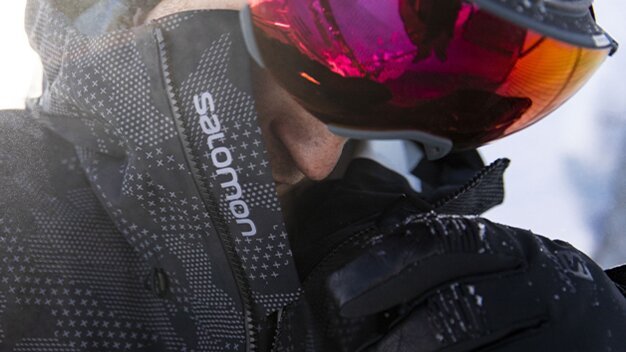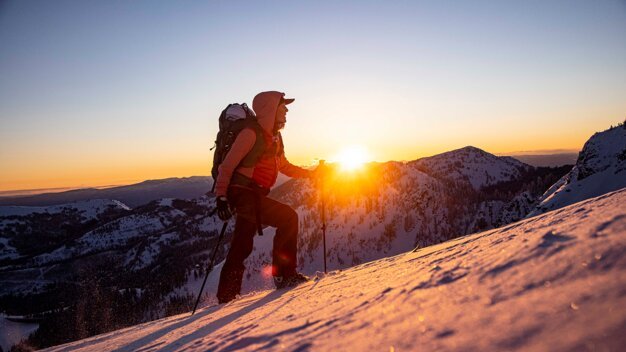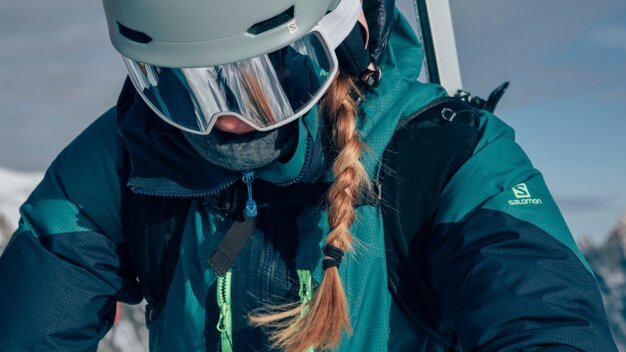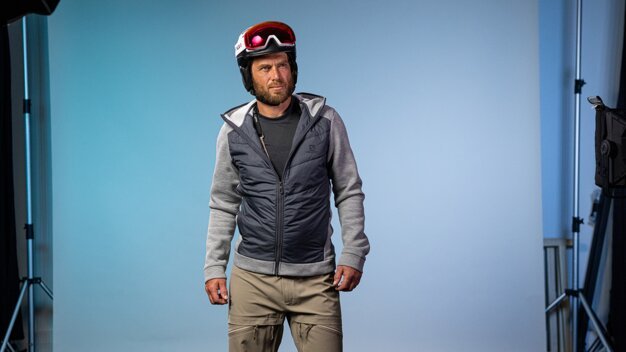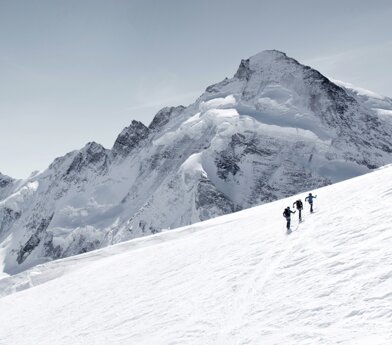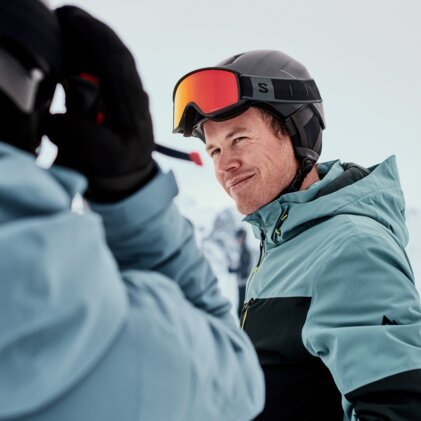
A day in the powder feels like freedom, adventure and real flow - but only with the right freeride equipment. Deep snow, untracked terrain and changing conditions require gear that protects, works and suits your style.
That's why, together with the mountain sports experts from Salomon, we have put together the ultimate tips for your freeride equipment.
What elements make up freeride equipment?
A good day of freeriding starts with gear that you can rely on in the backcountry. Off-piste, performance, safety and comfort are what count.
That's what you need in any case:
- Freeride skis, snowboard or splitboard (e.g. the QST 106 skis or SIGHT board from Salomon)
- Ski boots or snowboard boots to suit your setup
- (Freeride) poles
- Ski goggles with the right lens for good vision in powder
- Ski helmet for maximum protection ( e.g. the DRIVER helmet from Salomon )
- Optional depending on the route: climbing skins and crampons
This basic equipment ensures that you float in deep snow instead of sinking - and therefore have enough stability in the terrain.
What clothing do you need for off-piste skiing?
To ensure that you stay warm, dry and flexible in every situation when freeriding, it's best to wear suitable functional clothing. The key - as always in winter - is the onion principle.
Three layers that really count:
- Base layer
Transports moisture to the outside, keeping your skin dry. Base layers should be close-fitting and never made of cotton.
- Functional underwear (natural fibres such as merino wool or synthetic fabrics)
- Ski socks (natural fibres or synthetic materials such as polyester)
- Mid layer
A mid layer should be breathable and retain heat without restricting your freedom of movement. Make sure it has a comfortable, flexible cut.
- This includes fleece jackets, down hoodies or merino shirts, for example.
- Hardshell or outer shell
The outermost layer protects you from wind, rain and snow! Wind and waterproofness are particularly important criteria when choosing a hardshell jacket or a pair of trousers for freeriding.
- Weatherproof ski jacket and ski trousers
- e.g. MOON PATROL GORE-TEX JACKET and EDGE PANT M from Salomon
Don't forget your gloves, hat and a change of clothes:
- Gloves, hat and a change of clothes.
What safety equipment do you need in the backcountry?
With the right safety equipment, you can make better decisions, feel more confident and really enjoy your powder adventure. Remember that venturing off the designated slopes carries some risk. Therefore, it is essential to have the right off-piste safety equipment.
Your avalanche kit for runs off the beaten track:
Depending on the terrain, we also recommend
- Avalanche backpack with airbag system
- Back protector or protector vest
For responsible freeriding, it is also advisable to attend training courses on snow and avalanche awareness and to experience your first adventures together with experienced freeriding enthusiasts.
Which rucksack is suitable for freeriding?
Your backpack plays an important role when going into the backcountry. It has room for your equipment, safety tools and vital items for emergencies. The following features characterise a good freeride model:
- The rucksack should sit close to your body so as not to disturb your balance.
- Ergonomic padding and chest/back strap
- 18 to 32 litre volume, depending on the tour
- Ski or snowboard attachment
- Optional: integrated airbag system
What additional equipment do you need?
Ion top to the basic safety equipment, freeriding also requires some gear such as simple navigation aids and sufficient food to ensure orientation and energy even on remote tours. Depending on the nature of the trip, additional accessories may of course be necessary.
Navigation:
Reliable navigation on freeride adventures combines analogue and digital aids.
- Tour map, tour book or tour guide
- Compass or GPS
- Optionally an outdoor watch with altimeter
Ski care:
Sun lotion with a high sun protection factor is ideal, which also works reliably in snow, wind and sweat.
- Sun cream (SPF 30 to 50)
- Lip balm with UV protection
- Sunglasses an goggles with UV filter
Tip: The higher the altitude at which you are travelling, the greater the risk of snow blindness - so protect your eyes first and foremost!
Light sources:
Visibility and weather conditions can change quickly on the mountain. You should therefore have light sources with you as a safety and signalling device.
- Headlamp or torch
- Spare batteries
- Matches or lighter
First aid and repair kit:
- First aid kit
- Knife or multitool
- Tape
- Ski wax / small repair kit
Emergency gear:
From weather changes to injuries - you need to be able to react to unforeseen situations in the backcountry. Emergency equipment is therefore essential.
- Bivouac sack
- Rescue blanket
- Optional: tarpaulin or emergency tent
Food and water:
For your off-piste adventures, you need snacks that will reliably provide you with energy even in the cold. These should be easy to digest and simple to stow away.
- Sandwiches, energy bars, nuts, gels, etc.
- Water or tea
Personal items:
- Wallet
- Any personal medication
- ID and health insurance card
- Camera
- Fully charged smartphone
What's the best way to pack your off-piste ski equipment?
Packing stress in the morning? It doesn't have to be and increases the risk of forgetting important things. We recommend you pack your rucksack the evening before. That way, you can check everything in peace and start your freeride adventure relaxed. Why don’t you print out this checklist so that you can tick off all the points the evening before to be on the safe side.
Tip: Always pack your freeride backpack in the same order. This comes in useful because, you'll have everything to hand more quickly in an emergency and be confident.
Frequently asked questions about off-piste ski equipment
What is essential freeride equipment?
The basic equipment includes freeride skis or board, suitable ski boots or snowboard boots, poles, helmet, functional clothing in layers, complete avalanche equipment (avalanche transceiver, shovel, probe) as well as a freeride rucksack, navigation, sun protection, first aid kit and sufficient snacks and drinks.
How big should a freeride rucksack be?
In the freeride sector, a volume of 18 to 32 litres has proven itself for day tours in order to stow all the important items of equipment and supplies. For multiple day purposes the volume should increase accordingly.
What safety equipment is mandatory for freeriding?
In the backcountry, you absolutely need a complete avalanche kit: You must always have an transceiver, shovel and probe with you off-piste. A rucksack with an avalanche airbag can also provide additional protection. However, please note that safe handling of the equipment and regular training are essential in order to be able to react appropriately in an emergency.
Do I need crampons or climbing skins when off-piste skiing?
That depends on the terrain of your tour. For ascents under your own steam and on icy passages, climbing skins and crampons are essential. But even if you are using the gondola to get up on the mountain for some freeride runs you should consider bringing some skins in case you find yourself in a situation that requires some climbing.
What should I look out for in freeride skis?
Typical features are a pronounced centre width (95 mm to 125 mm depending on the model) for more flotation in powder, stable constructions for rough terrain and bindings that suit your skiing style. Then there's the shape: A rocker profile ensures that the skis don't sink into the snow. Use the opportunity to rent a variety of deep snow skis at INTERSPORT Rent.
Should freeride beginners attend training or courses?
Yes, this is highly recommended. Training courses on snow and avalanche awareness as well as guided tours with experienced instructors will help you to better assess risks and be safer in the terrain. Such courses also provide important information on how to use avalanche equipment the right way.
INTERSPORT Rent tip
The RENTertainer recommends
Do you already have all the important components for solid off-piste equipment? No? Then simply drop by INTERSPORT Rent!
In our more than 800 shops in Europe and Canada, you'll find a huge selection of freeride equipment to rent - from skis and snowboards to jackets for the backcountry, ski trousers and high-quality accessories. Any questions? Our local RENTertainers will be happy to share their powder knowledge with you!
Related articles
You may also be interested in:

